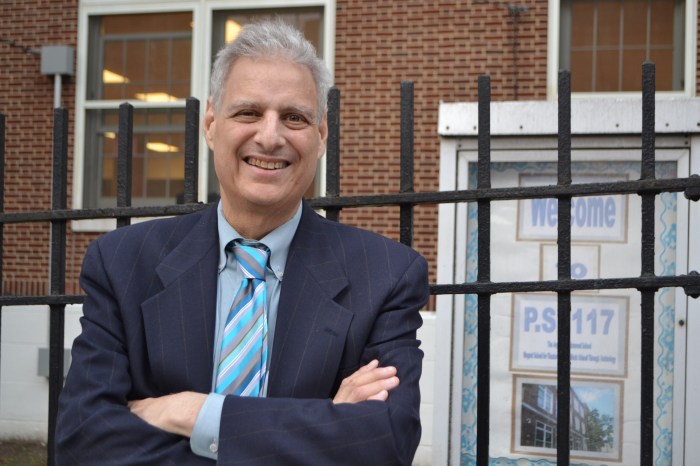When Nelle Stokes started Magic Box Productions in 2001, she was taking a leap of faith.
A documentary filmmaker and an actor, she had little experience in the classroom, but that did not deter her passion to teach. After years of determination, she became an approved arts-in-education vendor for the New York City Department of Education (DOE) and finally received her first education grant to teach at a brand new elementary school in Far Rockaway, Queens.
Her project was to help the students of the new school document their first year on film. Since then, Stokes and her creative crew have never looked back.
Stokes and her team of teaching artists have been teaching in New York City urban schools, such as P.S. 122 and P.S. 84 in Astoria, instructing elementary and middle school students in the fields of photography, basic documentary and animation.
“We’ll go in, partner with a teacher, usually social studies, language arts, or science,” explained Stokes. “We tend to work with the same schools over and over.”
Tali Hinkis, a teaching artist with Magic Box, believes that their work is important, and that it should be compulsory for students to express themselves creatively.
“Students are very excited about technology and are surprised and empowered to learn that they can create meaningful works of art or media with technological tools,” Hinkis said. “They are very intuitive and comfortable with learning new [technologies] which will no doubt be a part of their future.”
Unfortunately, with the current Wall Street meltdown, and possible DOE budget cuts, many students could be left out of this program. When the DOE is forced to make budget cuts, arts programs are usually near the top of the list.
Mayor Michael Bloomberg’s proposed $324 million cuts in education for next year, coupled with the inability of former Wall Street employees to donate, has sparked huge questions for the city’s art educators.
The upcoming 2009 fiscal year, according to Stokes, will be particularly tight, and money to non-profits and arts-in-education vendors like Magic Box will diminish, causing difficulty to non-profits looking to resume their work at the schools.
Stokes explained that Bloomberg’s current model for city schools is akin to a free market system where vendors like Stokes must contract with the principal at a given school. She explained that the school principal makes the decisions on what programs the school will spend on, and if the report cards are based largely on reading/math scores, “it is a fairly reasonable guess that the arts will be one of the things that they let go first.”
Under the recent reform by Bloomberg, schools that maintain a letter grade of “A” are entitled to more funding, which gives the principals “buying power” to keep arts in the schools. If a school is a failing school, it’s less likely to maintain funding.
This is not the first time that the arts programs faced a diminished role in the school system. In the 1970s, funding for arts education was taken out of the education budget and art teachers were laid off from many schools. In 1997, nearly two decades later, former Mayor Rudy Giuliani officially, yet painstakingly, reintroduced the arts. The initiative, known as Project Arts, allowed schools to spend $63 a year in arts education on each student in the school system, and reinstated art teachers.
By the year 2000, according to a report released by the Department of Education, 2,282 art teachers were back in the public school system as a reaction to the demand of school principals.
Today, more than 300 arts-in-education vendors, similar to Magic Box, contract with New York City schools in various areas – painting, music, drama, photography and many others. Each organization establishes a residency with a school. Some notable arts non-profits include Little Orchestra Society, Chinese Theater Works, Young Women’s Leadership Academy and Forward Motion Theater Inc., all of whom have residences in Long Island City and Astoria.
In order to survive, the non-profits must have plenty of their own funding as well, explained Gary Dayton, Program Officer at the New York State Council of the Arts. The Council is one of many sources the non-profits use to get funding, however, in the upcoming year that is about to change.
“Funding will be cut next year by 27 percent,” Dayton said. “New programs trying to get grants are really going to suffer next year.”
Maria Schwab, president of the Music Educator’s Association in New York City (MEANYC) and a full-time music teacher at P.S. 84 in Astoria, said the budget cuts have already affected teachers.
“In the MEANYC, we have two – no, more than two – teachers at other schools who are struggling for jobs this year because their programs were cut,” Schwab said. “There are drama teachers who now have to teach in the classroom.”
Meanwhile, the downturn on Wall Street has further complicated the problem. According to an article in The New York Sun, Merrill Lynch, Lehman Brothers and others had pledged large sums of money to the arts. When companies are acquired, the article said, their prior pledges tend to be honored. However, in general, “their cumulative philanthropic impact is diminished,” meaning that their total contribution would be less than they would have made as separate companies.
Furthermore, former Wall Street employees will likely not be giving next year, according to Stokes.
“Wall Street directly affects so many nonprofits, in several ways. One is individual giving often goes down, especially if the donors are employed in the financial sector,” she said. “Their ability to do this is tied to their portfolios, which have probably taken a big hit over the past weeks.”
Though the issue affects all non-profits, the larger ones will be affected more, Stokes explained, as they need more money to survive.
For now, Stokes and her teaching artists look forward to working in this academic year and will worry about the future later.
“Seeing students learn something is magical,” she said. “Getting to watch them do that is a gift.”



































